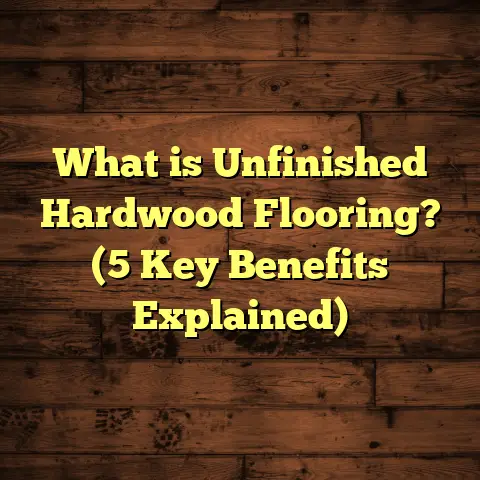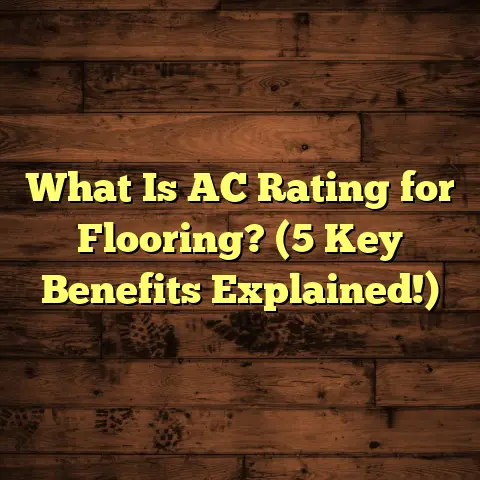What is Synthetic Wood Flooring? (5 Benefits You Need to Know!)
I remember when I first started working in flooring, one thing that immediately caught my attention was how much noise certain floors could make. You walk across a creaky hardwood floor, and suddenly the whole house feels louder. Or you drop something on a tile floor, and it echoes like crazy. That got me thinking about noise reduction, and how important it is to have a floor that feels comfortable underfoot—not just physically but acoustically too. Synthetic wood flooring came up a lot in conversations, especially for folks who wanted the look of wood but without the noise issues. So, what exactly is synthetic wood flooring? Let me break it down for you.
What Is Synthetic Wood Flooring?
Synthetic wood flooring is a type of flooring designed to mimic the appearance and sometimes the texture of natural wood, but it’s made from man-made materials. Unlike real hardwood that comes from trees, synthetic wood floors are typically manufactured using composites, vinyl, or other plastic-based materials. This means they don’t have the same vulnerability to moisture or scratching as real wood.
You might hear people call them vinyl plank flooring (LVP), luxury vinyl tiles (LVT), or engineered composites, but the basic idea is the same: these floors give you that warm, wood-like vibe without many of the headaches that come with real wood.
How It’s Made
Most synthetic wood floors are created by layering different materials. There’s usually a strong core made of wood composite or high-density fiberboard, topped with a photographic layer that looks like wood grain. Then, a protective wear layer seals everything to protect against stains, dents, and scratches. Some high-end versions even have textured surfaces to give you a more authentic feel underfoot.
When I installed a synthetic wood floor for a client last year, they were amazed at how closely it looked like oak but felt so much easier to clean and quieter to walk on. That’s one of the reasons synthetic wood flooring has become so popular.
Types of Synthetic Wood Flooring
There are several types of synthetic wood flooring available:
- Luxury Vinyl Plank (LVP): These are long planks that mimic hardwood very well and are waterproof in many cases.
- Laminate Flooring: Made with a fiberboard core and photographic wood layer topped with a protective coating. It’s durable but less water-resistant than vinyl.
- Engineered Composite Flooring: This category includes floors with a composite core and synthetic top layer designed to look like wood.
- WPC (Wood Plastic Composite) & SPC (Stone Plastic Composite): These are variations of vinyl flooring with different core materials for added durability and waterproofing.
Each type has its own pros and cons depending on your priorities like budget, moisture resistance, or installation ease.
1. Noise Reduction That Makes A Difference
Remember when I talked about noise earlier? Synthetic wood flooring often has better sound absorption properties than real hardwood or tile. Because of its layered construction and softer core materials, it reduces footstep noise and echoes inside a home.
In fact, a study by the Acoustical Society of America showed that vinyl plank floors with an underlayment can reduce noise levels by up to 20 decibels compared to bare hardwood or tile floors. That’s a huge difference if you live in an apartment with neighbors below or if you have kids running around constantly.
I had a family tell me they switched to synthetic wood flooring because their old hardwood floors would drive their baby crazy with every creak and pop. After installation, the house felt calmer, and even their dog seemed more relaxed.
Why Noise Matters More Than You Think
If you live in a busy household or an apartment building, noise can affect your peace of mind more than you realize. Hard surfaces like tile or hardwood reflect sound waves, which can amplify footsteps, dropped objects, or conversations. Synthetic wood’s built-in layers absorb sound waves better.
This means fewer complaints from neighbors downstairs and a quieter environment for work or relaxation at home. It’s not just about comfort; it’s about creating an atmosphere where your home feels like a sanctuary.
How You Can Maximize Noise Reduction
To get the best noise reduction benefits from synthetic wood flooring:
- Use a good quality underlayment underneath the floor. Cork or foam underlayments work well.
- Avoid hollow spaces beneath the floor by ensuring proper subfloor preparation.
- Consider thicker planks or floors with an acoustic backing layer.
I often recommend customers invest in quality underlayment because it’s affordable compared to what it does for soundproofing.
2. Durability That Stands Up to Life’s Messes
Synthetic wood floors are designed to be tough. Unlike real wood, which can scratch or dent easily, synthetic materials resist these kinds of damage better. The wear layer I mentioned earlier acts like a shield, protecting your floor from scuffs and spills.
To put this into perspective: independent lab tests show that high-quality vinyl plank floors can withstand over 10,000 cycles of abrasion without noticeable wear. By comparison, natural hardwood floors tend to show wear after only a few thousand cycles depending on the finish.
I once installed synthetic flooring in a busy retail store where there was heavy foot traffic daily. Even after several years, the floor looked nearly new — no scratches, no dull spots. For homes with pets or kids, this kind of resilience really pays off.
What Makes Synthetic Wood Flooring So Durable?
- Wear Layer: This transparent layer protects against scratches and stains.
- Composite Core: Provides stability and resistance to impact.
- Waterproof Technology: Prevents swelling and warping from moisture exposure.
It’s no surprise that synthetic wood flooring is often chosen for commercial spaces as well as homes because it balances beauty with toughness.
Real-Life Example From My Work
A couple with two active dogs told me their previous hardwood floors looked terrible after just one year—scratches everywhere and water damage near the dog bowls. After switching to synthetic wood flooring with enhanced wear resistance and waterproof features, their floors stayed pristine for years.
They said it handled everything from muddy paws to spilled drinks without a fuss.
3. Water Resistance Means Less Worry
One major drawback of hardwood is how it reacts to moisture. Spills can leave stains or cause warping if not cleaned quickly. Synthetic wood flooring mostly eliminates this problem because many types are water-resistant or even waterproof.
For example, luxury vinyl plank flooring is commonly rated as waterproof. This means you can install it in areas like kitchens, bathrooms, or basements without worrying about water damage.
In fact, according to recent market research by Floor Focus Magazine, waterproof synthetic wood floors have seen a 35% increase in popularity over the past five years because homeowners want worry-free options in moisture-prone areas.
I had a client spill red wine in their kitchen and simply wiped it up—no stains, no warping. They were thrilled because with hardwood, that would have been a disaster.
How Waterproof Are These Floors?
The waterproof rating varies depending on brand and type:
- Vinyl Planks: Usually 100% waterproof.
- Laminate: Water-resistant but not fully waterproof; prolonged exposure can cause damage.
- WPC/SPC: These composite cores offer excellent waterproof qualities.
If you’re considering areas like bathrooms or laundry rooms for synthetic wood flooring, make sure you pick products labeled as waterproof.
Tips To Protect Your Floor Even More
Even though many synthetic floors are waterproof:
- Clean spills promptly.
- Use mats near sinks or entryways.
- Avoid standing water for long periods.
These simple steps extend your floor’s life further.
4. Cost-Effective Without Compromising Style
One thing I often get asked is about price. Synthetic wood flooring usually costs less than real hardwood but still offers a beautiful finish that can suit many decorating styles.
On average, synthetic wood floors cost between $2 and $7 per square foot for materials and installation combined. Hardwood floors typically start around $8 per square foot and can go much higher depending on the species and finish.
So if you want the look of wood but are on a budget, synthetic options are well worth considering.
Breaking Down The Costs
Here’s what you might expect:
| Flooring Type | Material Cost (per sq ft) | Installation Cost (per sq ft) | Total Average Cost (per sq ft) |
|---|---|---|---|
| Hardwood (Oak) | $6 – $12 | $4 – $8 | $10 – $20 |
| Synthetic Wood (Vinyl) | $2 – $5 | $2 – $4 | $4 – $9 |
| Laminate | $1.50 – $3 | $2 – $5 | $3.50 – $8 |
Prices vary depending on region and product quality but synthetic floors generally save money upfront and over time due to lower maintenance costs.
Style Variety Without Breaking The Bank
Synthetic wood floors come in countless styles—from rustic reclaimed looks to sleek modern finishes. Some even replicate exotic woods that would cost thousands if real.
This means you can pick something unique without feeling limited by price.
5. Easier Installation and Maintenance
If you’re someone who likes DIY projects or wants to save on labor costs, synthetic wood flooring often comes with easier installation methods like click-lock planks or peel-and-stick backing.
From my experience installing dozens of these floors, I’ve noticed that laying synthetic wood floors takes roughly half the time compared to traditional hardwood installations. That means less disruption to your daily life.
Maintenance is simple too—regular sweeping and occasional mopping with mild cleaner keeps floors looking great. No need for sanding or refinishing every few years like hardwood requires.
Installation Methods Explained
- Click-Lock: Planks snap together without glue or nails.
- Glue-Down: Used in commercial settings; more permanent.
- Peel-and-Stick: Easy DIY option but less durable long-term.
I’ve had many customers successfully install their own synthetic floors thanks to clear instructions and user-friendly designs.
Maintenance Tips From My Experience
- Sweep or vacuum regularly to avoid grit scratching.
- Mop with gentle cleaners designed for vinyl or laminate.
- Avoid harsh chemicals or abrasive tools.
- Use furniture pads under legs to prevent dents.
Simple care routines keep your floor looking fresh for years.
Understanding Environmental Impact
One question I get asked often is about sustainability. How does synthetic wood flooring stack up environmentally?
Pros
- Many products use recycled materials in their cores.
- Longer lifespan means less frequent replacement.
- No need for harsh chemical finishes like some hardwoods require.
Cons
- Made from petroleum-based plastics which have environmental costs.
- Not all products are recyclable at end-of-life.
Still, manufacturers are improving eco-friendliness by reducing VOC emissions and increasing recycled content. If green building matters to you, ask suppliers about certifications like FloorScore or GREENGUARD that show low chemical emissions.
Comparing Synthetic Wood Flooring With Other Popular Floors
To help you see how synthetic wood fits among other choices:
| Feature | Synthetic Wood Flooring | Hardwood Flooring | Tile Flooring | Carpet |
|---|---|---|---|---|
| Noise Absorption | Good | Poor | Poor | Excellent |
| Water Resistance | High (waterproof options) | Low | Very High | Low |
| Durability | High | Medium | Very High | Low |
| Cost | Low-Medium | High | Medium | Low |
| Installation | Easy | Difficult | Moderate | Easy |
| Maintenance | Easy | Moderate | Easy | Moderate |
| Style Variety | Wide | Limited by species | Wide | Wide |
This shows why many homeowners choose synthetic wood flooring as a balanced option combining style with practicality.
My Personal Journey With Synthetic Wood Floors
Over the years as a flooring contractor, I’ve installed hundreds of synthetic wood floors in homes ranging from cozy apartments to large family houses.
One memorable project was for an elderly couple who wanted something warm underfoot but slip-resistant and quiet because their balance wasn’t what it used to be. Synthetic wood flooring gave them all that plus easy cleanup after their grandchildren visited.
Another time, I worked on renovating a historic home where preserving original elements was key but modern durability was needed too. Synthetic planks replicated old pine perfectly without risking damage from moisture or heavy foot traffic during renovation events.
These experiences taught me that synthetic wood flooring isn’t just “fake” wood—it’s a practical solution that fits real-life needs beautifully.
Addressing Common Questions About Synthetic Wood Flooring
Will It Look Fake?
With advances in printing technology and surface textures, high-quality synthetic floors look remarkably authentic—often indistinguishable from real wood at first glance.
If you want extra realism:
- Pick textured planks with embossed grain.
- Choose authentic colors rather than overly glossy finishes.
Is It Comfortable To Walk On?
Yes! Many types have softer cores than hardwood which makes walking barefoot more pleasant and reduces fatigue during long standing periods.
Can I Install It Over My Existing Floor?
Often yes! Many people install synthetic wood over concrete slabs, vinyl tiles, or even existing hardwood if the surface is flat and clean enough.
How Long Will It Last?
Typically 15-25 years depending on quality and maintenance—comparable to mid-range hardwood finishes without refinishing hassle.
Final Thoughts
If you want floors that cut down noise,
handle life’s spills,
stay looking nice for years,
and don’t break the bank,
synthetic wood flooring is definitely worth checking out.
I’ve seen it work wonders in all kinds of homes—from busy families to pet owners—offering peace of mind while keeping style front and center.
Got questions about whether synthetic wood flooring fits your space? Just ask! I’m here to help make your next flooring choice easy and smart.





